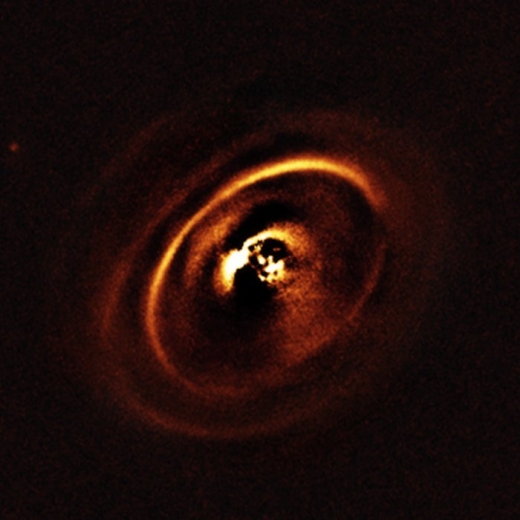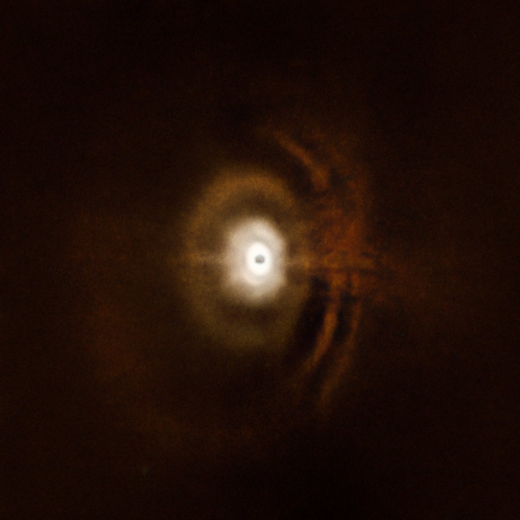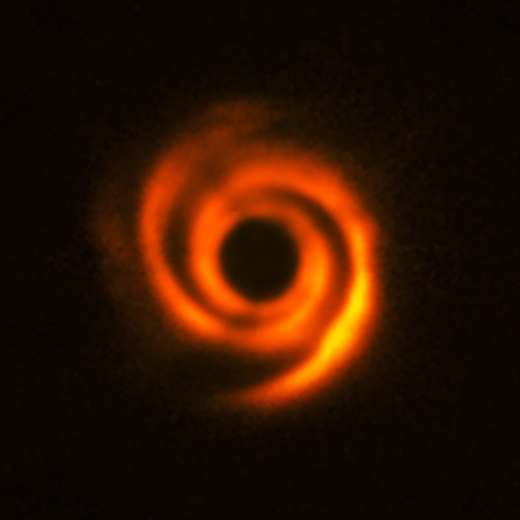Our knowledge of protoplanetary disks around young stars is deepening. This morning we have news of three recently examined disks, each with features of interest because we know so little about how such disks evolve. What we do know is that planets are spawned from the gas and dust we find within them, as we see in the disk below discovered using the SPHERE instrument on the European Southern Observatory’s Very Large Telescope in Chile.

Image: A team of astronomers observed the planetary disc surrounding the star RX J1615, which lies in the constellation of Scorpius, 600 light-years from Earth. The observations show a complex system of concentric rings surrounding the young star, forming a shape resembling a titanic version of the rings that encircle Saturn. Such an intricate sculpting of rings in a protoplanetary disc has only been imaged a handful of times before. Credit: ESO, J. de Boer et al.
The comparison with Saturn is not amiss, for this is a complex system of concentric rings that is uncommon among protoplanetary disks we’ve found so far. While dating such systems is difficult, astronomers believe this disk is a bit less than 2 million years old. Bear in mind that we’re still trying to work out the mechanisms that cause these sculpted effects. They’re surely the result of planets in formation, but it’s worth noting that while the disk around RX J1615 is strikingly regular, we’re just as likely to encounter gaps, voids and spiral arms in such disks.
The work here is from Jos de Boer (Leiden Observatory), who has put the SPHERE instrument to good use. SPHERE (Spectro-Polarimetric High-contrast Exoplanet REsearch) was built as a planet imager, one that would take direct images of exoplanets rather than detecting them through their star’s Doppler shifts or through transits of the planet. An advanced coronagraph, SPHERE blocks out the central star, using a polarimetric differential imaging mode that draws on the fact that the light of the star is unpolarized, while the light scattered by the disk is polarized, allowing sharp images of the disk to be extracted.
Another researcher from Leiden University, Christian Ginski, is behind work on a different young system. The star is HD 97048, about 500 light years from Earth. Here again we see a striking symmetry in the ring system. Four gaps and rings can be found here. But finding any planets that are sculpting this system is not going to be easy, as the paper on this work notes:
We find that nascent planets are one possible explanation for the structures that we are observing. However, given the low planet masses needed to carve out the gaps that we detected, it is unlikely that the planet’s thermal radiation is directly detectable by current generation planet search instruments such as SPHERE or GPI [Gemini Planet Imager]. This conclusion is strengthened by the fact that the gaps are most likely not completely devoid of material and thus any thermal radiation from a planet inside the gap would be attenuated by the remaining dust.

Image: The planetary disc surrounding the star HD 97048 in the constellation of Chameleon, about 500 light-years from Earth. The juvenile disc is formed into concentric rings. This symmetry is in contrast to most protoplanetary systems which contain asymmetrical spiral arms, voids and vortexes. The displayed image is a composite derived from two independent observations that targeted the inner and outer regions of this disc. The central part of the image appears dark because SPHERE blocks out the light from the brilliant central star to reveal the much fainter structures surrounding it. Credit: ESO, C. Ginski et al.
Contrast the two disks above with what Tomas Stolker and colleagues (Anton Pannekoek Institute for Astronomy, the Netherlands) have found. In the image below, we’re looking at HD 135344B, some 450 light years from Earth. Here the disk is obviously asymmetrical, consisting of a central cavity and two spiral arms thought to be the result of planet formation.
And in this system we have a feature that changed noticeably in the months between observing periods. The feature in question is one of the dark streaks that are evidently shadows created by material in motion within the protoplanetary disk. Planetary evolution in real time? That’s what this ESO news release calls it, an indication of the level of detail we can pick out in the inner disk regions of some stars with the SPHERE instrument.
The paper puts the matter this way:
The variable or transient nature of this shadow could be explained by several scenarios, including a local perturbation of the inner disk or an accretion funnel flow from the inner disk onto the star.

Image: The planetary disc surrounding the star HD 135344B, about 450 light-years away. The disc shows prominent spiral arm-like structures. Credit: ESO, T. Stolker et al.
In any case, we’re seeing change within months in this evolving system. And as to the spiral arms themselves:
An explanation for the spiral arms could not be uniquely determined. In the context of linear perturbation theory, the spiral arms are best explained by two protoplanets orbiting exterior of the spiral arms. Protoplanet solutions inside the scattered light cavity seem unlikely because the spiral arm pitch angles would require unphysical disk temperatures.
Understanding how planets shape the disks from which they form is a step forward in planet formation theory, and it’s clear that the environment of young systems like these is complex and varied enough to produce a wide range of outcomes in the evolving disk.
The papers are de Boer et al., “Multiple rings in the transition disk and companion candidates
around RX J1615.3-3255. High contrast imaging with VLT/SPHERE,” Astronomy & Astrophysics 595 (2016), A114 (preprint). On HD 97048, the paper is Ginski et al., “Direct detection of scattered light gaps in the transitional disk around HD 97048 with VLT/SPHERE,” accepted for publication at Astronomy & Astrophysics (preprint). The paper on HD 135344B is Stolker et al., “Shadows cast on the transition disk of HD 135344B,” accepted at Astronomy & Astrophysics (preprint).



Every time I see an image like this I am blown away that seeing these disks is even possible. It seems that this was unimaginable not so long ago. No doubt we will be seeing planets as more that the blurry pixels of a super Jupiter , hopefully in my lifetime.
When we see these spiral structures you can see how it is possible for planets to get so close to some stars, they follow the inflowing material.
I wonder if anything can be said about the obliquity of these “swarms”? Are these particles in a close plane, or is that asking too much from already marvelous data?
That’s a good question, Michael, and one I’ll need to follow up on. Don’t know at the moment, but will see what I can learn. It seems to me work has been done on this re Beta Pictoris.
Hi Michael,
As a matter of fact, it is possible to determine that the first two disks (RX J1615 and HD97048) aren’t flat, based on these images alone.
I’m not entirely sure what you mean with obliquitiy in this question (this term is normally reserved for the angle between the spin axis of the star and the (normal to the) plane of the disk), so I assume your question is about whether or not the disk itself lies in a flat plane.
Think about a soup-bowl in which you draw rings with increasing radius from the center of the bowl. When you look at the bowl from the top, the rings would be circular and centered around the point in the middle. But when you tilt the soup bowl, the rings will become elliptical and the center of the bowl will appear to shift towards the side which faces you, until you have tilted it (too far) and the center will cross the ellipses.
When we assume that the rings are circular and centered around the star (not necessarily true, but still the most likely scenario), the fact that we see them as ellipses is caused by the inclination of the system: we don’t see the disk from a pole-on position but along an inclination angle > 0. If the disks would have been flat, concentric rings seen under an inclined angle would appear like ellipses that are centered around the star. However, this is not what you see in the images. From the inside-out, the ellipse-centers seem to move further away from the center with each new ring. This is probably because the circular rings do not lie on a flat plane, but on a surface for which the height above the “mid-plane” increases with radius. The side of the disks closest to us is then the side where the rings seem closest together.
Bottom line: the disks are probably quite thick, with the height increasing with the separation from the star. This is in agreement with what theory predicts for protoplanetary disks.
The planetary disc surrounding the star HD 135344B, about 450 light-years away. The disc shows prominent spiral arm-like structures. Credit: ESO, T. Stolker et al.
In that picture, are the three shadows an artifact of the light gathering, processing and chronograph?
The central dark disc should be the coronagraph blocking out the light of the star, Otherwise, we’re looking at spiral structures, with the dark lanes showing the opening between the structures. I assume that’s the shadow reference you’re asking about.
In the last picture, there are 3 significant radial shadows, at about 11, 2 and 7 o’clock, and 3 very faint ones at about 3, 4 and 9 o’clock although the one at 3 does not seem to extend all the way to the center like the others. While I am a bit of a photographer and I’ve always loved Space and stars, I’ve never had the opportunity to use telescopes, I have read though that it’s the design of the telescope that produces the crosshair like design on stars, I figure that some aberration like that is what’s causing these shadows, but the little kid in me wants to know if they could be shadows cast from objects near the star
To me the dark areas look 120 degrees apart which is where LaGrange points would be.